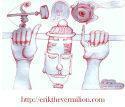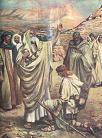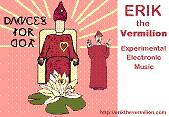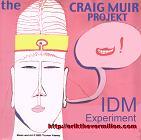Be Kind! Share with your Team, with your Family, with your Buddies!
Click The Button Now & Like This On Your Facebook Page!
Wednesday, January 25, 2012
The Water Cycle
Water contains two elements - hydrogen and oxygen. Each molecule contains 2 parts of hydrogen to 1 part oxygen.
The greatest amount of the Earth's water resides in the sea and the seas cover about 70% of the surface of the planet. The rest is in the polar ice caps, rivers, lakes, reservoirs, clouds, sea ice, and locked underground in aquifers.
The water in the sea contains salt so is not drinkable, but the other sources previously mentioned are mainly fresh and it is this that we need to drink.
Water is always moving around in something that is called The Water Cycle. Basically, water that is exposed to the sun evaporates and the vapour that is releases eventually forms a cloud. When the cloud can take no more liquid, it rains and the water falls back down again where the whole process continues.
The balance of water on the planet remains fairly similar at all times, but individual molecules move around, in and out of the atmosphere. Water moves from one reservoir to another and goes through all the phases of solid, liquid and gas.
There are a few processes involved in the water cycle: evaporation, condensation, precipitation, infiltration, subsurface runoff and surface runoff.
The sun drives The Water Cycle with evaporation. Evaporation involves the water taking up energy from the surroundings and therefore cooling the environment. The liquid water turns into a gas and this rises into the atmosphere.
In the atmosphere, the particles collide and become larger, forming clouds. This happens through the process of condensation where the gas reverts back to a liquid.
Precipitation is just the scientific name for rain.Rain falls onto land, sea, and bodies of fresh water. It can also fall as snow or hail.
Water that falls on the land infiltrates soil and ends up at the groundwater supply, topping it up. The water flows under the surface and find its way to the rivers and sea. The water moving underground is the subsurface runoff.
Other water that falls on the land runs off it into streams and rivers - this is called the surface runoff. It then enters the rivers and seas and will be subject to evaporation again.
There is another way that water can get into the atmosphere and that is via the transpiration of trees. Trees pull groundwater from their roots and transport it the pores on their leaves where it evaporates - this process is called evapotranspiration. About 10% of the water in the atmosphere gets there by evapotranspiration. It is then condensed into clouds and falls again through precipitation.
Water comes from many places on this planet, but it is sure to have been to more places than you think due to The Water Cycle.
Next time you drink a glass of water from the office water coolers or your tap at home, pause to think about the incredible journey it has taken to get there.















